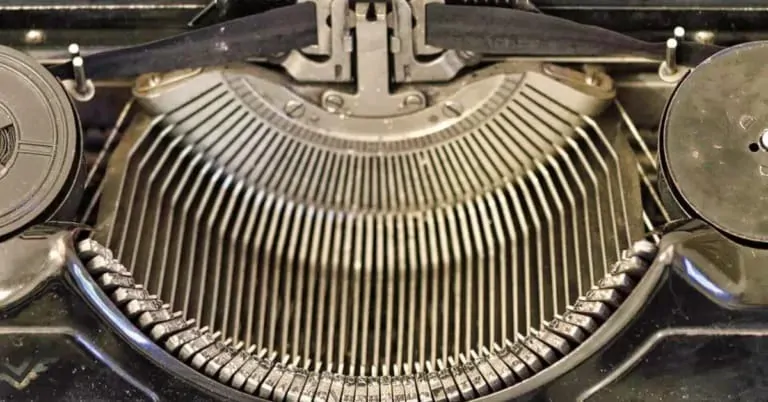Ninety percent. I’m not sure what this is… Please Share If You Know
“Traveling Through Time: The Enduring Charm of Typewriters and Their Timeless Allure”
In my treasury of cherished memories, one moment stands out, deeply rooted in my mother’s role as a dedicated journalist. It was a time when words flowed gracefully from the keys of a typewriter—a captivating device that has left an indelible mark on my memory. Seated on my mother’s lap, I watched in fascination as her fingers danced across the typewriter’s keyboard.
The scent of paper mingled enchantingly with the ink’s alluring aroma, creating an atmosphere of creation and remembrance. These typewriters, each a masterpiece in its own right, housed a diverse range of models, each with its unique mechanical heart. As I reflect on those days, I’m compelled to ask you, dear reader: Do you own a typewriter?
Typewriters Unveiled in a Nostalgic Journey
The humble typewriter serves as a poignant symbol of a bygone era, a tribute to a different era of communication in a world now dominated by digital marvels and touchscreen experiences.
The tactile symphony of keys striking paper bore witness to the transmission of thoughts and stories in a tangible manner. In the following sections, we’ll delve into the historical lineage and enduring legacy of these remarkable writing machines.

The Ingenious Evolution of Typewriters:
Looking back, we trace the roots of mechanical writing devices planted in the 18th century. However, it was in the 19th century that functional typewriters began to emerge. The Sholes and Glidden typewriter, often known as the Remington No. 1, made its debut in 1873 as a pioneering example.
With this development, a significant stride toward mechanical writing was taken. The introduction of these early typewriters introduced the “QWERTY” keyboard layout, a layout still used on modern computers and smartphones. This layout was designed with foresight to alleviate the frequent jamming of letter combinations in mechanical typewriters.
The Ripple Effect on Communication and Society:
The introduction of typewriters onto the stage of innovation sent ripples far and wide, leaving an enduring imprint on communication and society. This realm of influence invites us to pause and contemplate:
- Increased Speed and Efficiency: Typewriters revolutionized the landscape of writing and document creation. Skilled typists orchestrated a symphony of faster composition, surpassing the era of handwritten transcripts. The fruits of this transformation resonated across workplaces and industries, ushering in heightened efficiency.
- Document Standardization: Each keystroke on a typewriter yielded a mark of consistency—a uniformity that lent itself to documents imbued with precision. This feature held particular significance in crafting legal and official writings.
- Pioneering Journalism and Publications: The advent of typewriters accelerated the pace of the newspaper profession. The rhythmic dance of keys paved the way for the swift compilation of news articles, ushering in an era where newspapers emerged as the predominant source of information.
- Democratization of Writing: Typewriters rolled out the metaphorical red carpet to a broader population, introducing them to the realm of professional writing and correspondence. The gradual decrease in typewriter prices opened doors for many.
- Preservation of Legacies: Typewritten documents exhibited unwavering durability, a tenacity rarely matched by their handwritten counterparts. This resilience was essential in safeguarding historical records and literary treasures.
A Legacy Perpetuated: A Glimpse into the Contemporary Tapestry
Despite the digital surge nudging typewriters to the periphery, their legacy endures, interwoven with modern themes:
- Coveted Antiques: Vintage typewriters, steeped in the patina of yesteryears, have risen to prominence as sought-after antiques. Their allure lies not only in their design but also in the stories they hold and the history they embody.
- The Echo of Keys: The resonant clatter of typewriter keys and the tactile communion between fingers and keys evoke a nostalgic reverie. Some writers still cherish this tactile practice as a wellspring of creative inspiration.
- Artistry and Innovation: Artists and designers infuse typewritten text into their works, combining the vintage spirit of typewriters with the palette of contemporary creativity. This delicate interplay between eras breathes new life into their creations.
Typewriters have adorned the pages of literature, the frames of films, and the canvases of art. Their presence invokes eras long past and imparts a timeless quality to these depictions.
The rhythmic clatter of typewriter keys continues to resonate in tranquil writing retreats and immersive workshops. It serves as a tool for concentration and imagination, igniting creativity in those who wield it.
The typewriter, a mechanical virtuoso that orchestrated symphonies of prose and verse, still echoes through the corridors of time. Its evolution has been intertwined with the development of written language, from humble beginnings to sleek embodiments of utility.
While the banner of technological progress may have shifted, the legacy of the typewriter continues to illuminate the paths of writers, artists, and enthusiasts alike. It serves as a tangible bridge connecting the realm of typing with the art of crafting words on parchment through its rhythmic cadence.
The typewriter stands as an evoc




